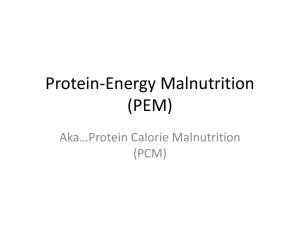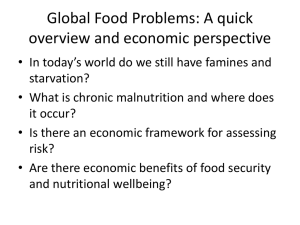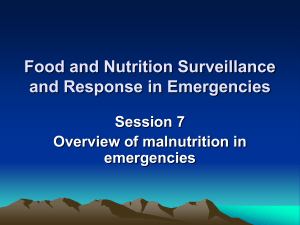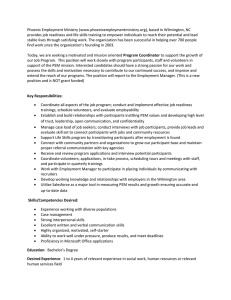Protein Energy Malnutrition (PEM) in Children Arturo S. Gastañaduy M.D.
advertisement
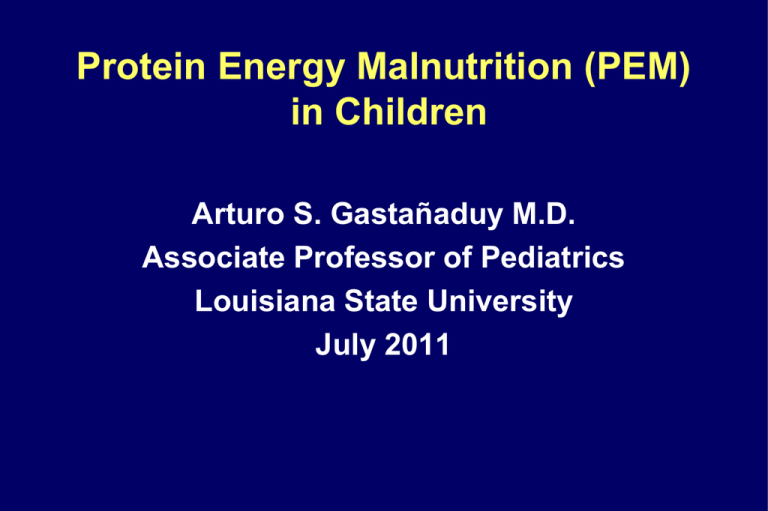
Protein Energy Malnutrition (PEM) in Children Arturo S. Gastañaduy M.D. Associate Professor of Pediatrics Louisiana State University July 2011 Learning Objectives Epidemiology of PEM in children of developing and developed countries Diagnosis and management of childhood PEM Specific interventions for prevention of PEM Immediate Causes of Childhood Deaths: 2008 Global Trends in the Prevalence of Moderate-Severe Malnutrition in Children Under Five Region 1990 1995 2000 2008 % Million % Million % Million % Africa 27.3 30.1 27.9 34.0 28.5 38.3 24 Asia 36.5 141.3 32.8 121.0 29.0 108.0 31 LatinAmerica 10.2 5.6 8.3 4.5 6.3 3.4 7.0 Developing world 32.1 177.0 29.2 159.5 26.7 149.6 22 Million 178.0 Prevalence (%) of Moderate-Severe Malnutrition in Children Under Five in Selected Countries (From World Health Organization Data Base) Country/Year Weight/Age Height/Age Weight/Height -2 SD -2 SD -2 SD USA/2004 1.5 4.1 0.7 Germany/2006 1.2 1.5 1.1 Belarus/2005 1.8 5.7 2.8 Bulgaria/2004 2.6 12.7 4.5 Ukraine/2000 5.4 35.6 12 China/1998 8.2 25.6 3.0 Protein Energy Malnutrition WHO Classification Moderate Edema No Severe Yes Wt / Ht Deficit1 (%)2 2-3 (70-79) >3 (<70) Ht /Age Deficit1 (%)2 2-3 (85-89) >3 (<85) 1 Standard deviation from median of reference population 2 Percentage of the median of reference population: NCHS/WHO Protein Energy Malnutrition Waterlow Classification Ht/Age Wt/Ht SD Median 1-2 % Median 80-89 SD Median 1-2 % Median 90-95 Moderate 2-3 70-79 2-3 85-90 Severe >3 <70 >3 <85 Mild Mac LAREN SCORE CLINICAL FINDINGS Edema Dermatosis Edema & Dermatosis Hair Changes Hepatomegaly Serum Albumin POINTS 3 2 6 1 1 0-7 (1 point for every 0.5 gram below 3.5 gm/dl) TYPES OF MALNUTRITION TYPE Mac Laren SCORE Marasmus (M) Marasmus – Kwashiorkor (MK)* Kwashiorkor (K)* 0-3 4-8 > 9 *All MK and K patients have third degree malnutrition regardless of weight deficit (or excess) Why is the new WHO classification recommended? • It is practical • Combines severity and type of malnutrition in one table • It does not require a laboratory or sophisticated equipment • It is easy to teach and use in the field • It has proven its utility in disaster situations Protein Energy Malnutrition Basis of Management 1. Restore and maintain hydro electrolytic balance. 2. Aggressive diagnosis and treatment of infections. 3. Nutritional therapy: oral feeding. 4. Prevention and treatment of complications. 5. Physical and psychological stimulation. 6. Parental education and social evaluation. Assessment of Hydration Status: History Diarrhea/day Vomiting/day Urine/last 12 hours Mild Moderate Severe 1-5 0-3 >2 6-10 4-6 1-2 >10 >6 0 Assessment of Hydration Status: Physical Examination Mental Status Response to stimulus Oral Mucosa Tenting (Chest) Peripheral Pulses Mild Moderate Severe Alert Cry Mild Dry No Present Depressed Weak cry Dry <2 sec. Weak Coma No cry “parrot” >2 sec. No felt Unreliable Signs of Dehydration in severely malnourished children *Sunken Eyes: Normal in Marasmus patients Can not be seen with edema *Tenting (abdomen) Normal in Marasmus patients Difficult to assess with edema or abdominal distention *Capillary refill (peripheral) Usually delayed: cold extremities edema Assessment of Hydro-electrolytic Status: Laboratory evaluation Basic Advanced Hematocrit Total serum protein Urine specific gravity Accucheck BMP CMP Zn, Cu, others Stool electrolytes Expected Hydro-electrolytic Changes (“Well Hydrated” patient) Total Body Water Sodium Potassium Excess Excess Deficit Serum Normal - Low Normal 132-+ 4 mEq/L 3.5 + 1 mEq/L Albumin Globulin Sodium Potassium Urine Specific Gravity 1010 + 5 Treatment of Dehydration Rehydration Mild Moderate Severe ReSoMal ReSoMal IV Fluids* 80cc/kg 8 hrs IV Fluids* 50cc/kg in 4 hrs 100 cc/Kg 12 hrs Replacement Volume to Volume: ReSoMal. Maintenance Feeding immediately after rehydration. * RL or NS: 20 cc/kg bolus as needed. Add Dextrose 5% ORS for Diarrhea and Malnutrition Component (mmol / L) Normal ORS ReSoMal Glucose Sodium Potassium Chloride 111 90 - 75 20 80 125 45 40 70 Citrate Magnesium Zinc 20 - 7 3 0.3 Copper Osmolality 310 0.045 300 Management of Infections in PEM Effect of PEM in the Immune System • Cell Mediated Immunity • Ig A levels in secretions • Phagocyte Killing • Inflammatory response • Signs of infection ( Fever, WBC count) • Hypoglycemia and Hypothermia are signs of severe infection or septic shock Management of Infections in PEM Therefore: • Infections are the rule • Multiple infections coexist • Diagnosis as aggressive as possible • Empiric treatment should be started immediately Management of Infections: Laboratory Evaluation Basic Advanced WBC & Differential Cultures: Blood Urine dipstick Urine Stool microscopy Stool lugol, methylene blue Others Scotch tape Ova and Parasites x3 KOH Duodenal aspirate Thick blood smear CXR, PPD, Serology for Infections in Severely Malnourished Children Points to Remember * PEM patients are immunosuppressed (Cellular) * Gram Negative enteric bacteria are common * Rule out sepsis: Fever, hypothermia, poor feeding, abdominal distention, paralytic ileus, lethargy * Most deaths occur in 1st 48 hours of admission * Risk factors: Age <6m especially <4m, Edema, Jaundice Petechiae, Respiratory distress * Suspect Infection: Poor weight gain, persistent edema Treatment of Common Infections DIARRHEA: Watery: Usually non-specific Hydration-Nutrition Cholera: Doxycycline, single dose Tetracycline x 3 days Ciprofloxacin, TMP-SMX Bloody: SEPSIS: Shiguella: Ampicillin, TMP-SMX x 5days Ciprofloxacin, Ceftriaxone Campylobacter: Erythromycin x 5 d Azythromycin Ceftriaxone: 100 mg/Kg/day IV X 10-14 days Amikacin: 15 mg/Kg/day IV X 10-14 days Treatment of Common Infections UTI: TMP-SMX, Cephalosporin 3, Gentamicin PNEUMONIA: Ceftriaxone 100mg/Kg/day IV X 2 days Consider Vancomycin OTITIS: Amoxicillin 90 mg/Kg/day PO X 10 days Infection Management: WHO No apparent complications Complications: lethargy, fever, hypothermia, hypoglycemia TMP/SMX BID for 5 days Ampicillin 50 mg/Kg IM/IV Q 6 hours for 2 days Amoxicillin 15 mg/kg PO Q 8 hours for 5 days + Gentamicin 7.5 mg/Kg IM/IV QD for 7 days If no improvement in 48 hours add Chloramphenicol 25 mg/Kg IM/IV For 5 days Other Important infections TBC: No weight gain could be only sign PPD usually negative, check for exposure Drug therapy according to local susceptibility UTI: Common US, IVP, & VCUG for recurrent disease Parasites: Giardia: Metronidazole, Tinidazole Strongyloides: Ivermectin, Albendazole Ascaris: Albendazole, Mebendazole HIV: Increasing Prevalence Wasting syndrome: Poor prognosis Management: depends on drug availability Nutritional Therapy in PEM Effects of PEM on the GI System • Gastric acid production • Intestinal motility • Bile & Pancreatic enzymes • Nutrient absorption • Atrophy of intestinal mucosa GI infections and diarrhea are very common Diet (Formula) Composition 1. Energy provided by: Protein Fat Carbohydrate 8-10 % 45 % 45 % 2. Volume: Marasmus MK - K 100 - 120ml/kg/day 75 ml/kg/day Formula (Diet) Composition 3. Caloric Density 4. Osmolality 5 Sodium 6. Potassium: Marasmus: Kwashiorkor: 7. Vitamins & Minerals .75 - 1.2 kcal/ml < 300 m 0sm/L 2 mEq/Kg/day 3 mEq/Kg/day 5-8 mEq/Kg/day > 1.5 RDA Useful Diets for the Treatment of Severe Malnutrition DIET COMMENT Breast Milk Cow’s Milk Lactose - Free Formulas Milk- Staple + Oil Cereal – Legume Chicken Based WHO: F75, F100 Use it when available Lactose-malabsorption possible Expensive- Not available Safe, inexpensive, available Inexpensive, available Also Useful No kitchen , out-patient Milk-Rice-Oil Diet Composition Amount* (g) Milk** 7.0 Rice Flour 10.0 Vegetable Oil 3.9 TOTAL (% of energy) Energy* (Kcal) 33.3 35.9 30.7 100.0 Protein* (g) Fat* (g) CHO* (g) 1.9 0.6 -2.5 1.80 0.07 3.41 5.25 2.4 7.9 --10.3 10.0 48.8 41.2 Water added to complete 100-125ml/Kg/day. Vitamins and Minerals to satisfy 1.5 RDA. * Amount /Kg/day. ** Whole dried cow milk Preparation of WHO F-75 and F-100 diets Ingredients F-75 F-100 Dry skimmed milk (g) Sugar (g) 25 80 70 50 Cereal flour (g) 35 - Vegetable oil (g) 27 60 Add: vitamin mix 140 mg, mineral mix 20 ml and water to make 1,000 ml Nutrient in 100 ml of F-75 and F-100 diets Energy (kcal) Protein (g) Fat (g) CHO (g) Lactose (g) Potassium (mmol) Sodium (mmol) Magnesium(mmol) Zinc (mg) Cooper (mg) mOsmol/L F-75 75 0.9 2.7 11.8 1.3 3.6 0.6 0.43 2.0 0.25 333 F-100 100 2.9 5.9 8.75 4.2 5.9 1.9 0.73 2.3 0.25 419 Volume (ml) of F-75 per feed to provide 100 Kcal/kg/day Wt (kg) 2.8 3.2 Q 2h 30 35 Q 3h 45 55 Q 4h 60 70 3.6 4.0 4.6 40 45 50 60 65 75 80 90 100 5.0 5.4 6.0 55 60 65 80 90 100 110 120 130 Treatment and Prevention of Complications Hypoglycemia: Hypothermia: Hypoprothrombinemia: Vitamin A Deficiency Hypomagnesaemia Hypocupremia Severe Anemia Prevent Infections Frequent feedings (Q2-3h) Dextrose 5% in IV Fluids Keep patient warm, quick and organized bath and changing of clothing Vat. K 1 mg IM on admission Vit. A 50,000 - 100,000, 200,00 IU Mg So4 1-2 mEq/Kg/day Cu So4 -15mg/Kg/day (1%Sol) Pack RBC 10ml/Kg Routine Immunization, Isolation procedures as needed Psycho-Sensorial Stimulation Effect of PEM on the Central Nervous System • Brain Size • Cortical Thickness • Synaptic Connections • Neurotransmitters • PEM Vs Emotional Deprivation • Recovery Towards “Normal “ is the rule Gunston, G.D. et al. Reversible cerebral shrinkage in Kwashiorkor: an MRI study. Arch Dis Child. 1992, 67: 1030-1032 Psycho-Sensorial Stimulation • • • • • • • • Start immediately Encourage parental participation No limits for visiting hours Surrogate mothers and aunts Play therapist Toys Bright colors Songs, Music Parental Education & Social Evaluation • Start immediately • Practical Hygiene Measures • Hand washing, safe excretal disposal • Clean & Nutritional appropriate diets • Breast feeding, avoid bottles • Solid foods, Food preparation, Best buy • Health Education: Immunizations • Social services Protein Energy Malnutrition Time-Frame for Therapy Treat Dehydration Electrolyte imbalance Hypoglycemia Hypothermia Infections Feeding Micro nut. Deficits Psychosensorial Days 1-2 Days 3-7 Weeks 2-6 --------- - - - - - > ---------------------------------------------------- -------- - - - - - - > -------- - - - - - - > -------------------------- Begin------------------- No iron ----------------- Weeks 7-26 Increase-------------------------- With Iron- --------------------------------------------------------------------------- * Modified from Management of severe malnutrition: a manual for physicians and other senior health workers, WHO Geneva 1999 Prevention of Malnutrition Interventions that work • Maternal and birth outcomes: Maternal supplements micronutrients* Reduce tobacco consumption* • Newborn babies: Promotion of breast feeding by Individual and group counseling Prevention of Malnutrition Interventions that work • Immunization* • Hygiene: Hand washing, excretal disposal* • Vitamin A, Zn, Iodine* • Treatment of diarrhea and acute malnutrition* • Malaria prevention* • Education for complementary feedings*
